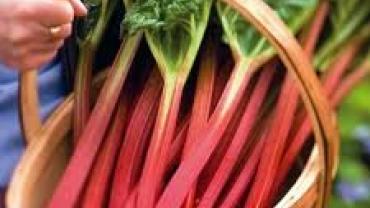
Along with juicy peaches and boldly colored ripe berries that explode with sweetness another food at home on picnic tables in summer is rhubarb. By itself rhubarb is extremely tart so it is most often consumed as part of a sweeter dish such as strawberry rhubarb pie or cooked into rhubarb jams and preserves. This makes rhubarb much more palatable which is good because rhubarb is nutritious and delivers health benefits. However the copious amounts of sugar used in these products—even homemade versions—can turn this otherwise healthful food into something that should be consumed only sparingly.
The shape of rhubarb resembles Swiss chard with long thick stalks—called petioles—growing out of the ground and large leaves sprouting from the top of the stalks. The color of the stalks varies ranging from light green where they look like celery to light pink to deep red. But any similarities between rhubarb and celery stop at appearances. With rhubarb’s powerful sour flavor no one biting into a raw stalk would ever mistake it for celery. As sold in stores rhubarb is almost always trimmed of its leaves. This is because the leaves—like those of chard—are very high in oxalic acid a compound that binds minerals making them less available for absorption and assimilation in the body. Excessive consumption of high-oxalate foods may increase the risk for formation of insoluble calcium oxalate stones in the kidneys and individuals suffering from gout are advised to limit high-oxalate foods. Oxalic acid is present in the stalks but in a much lower concentration which is unlikely to cause problems.
The potential toxicity from consuming the leaves should not scare people away from consuming the stalks. These safely edible parts of rhubarb are a good source of vitamins C and K1 along with manganese and potassium. As a very low-starch high water content vegetable a cup of diced rhubarb (about 122g) provides just 26 calories mostly coming from its 6 grams of carbohydrate of which 2 grams are fiber. This makes rhubarb a great choice for low-carbohydrate diets provided of course it isn’t consumed with large amounts of sugar.
Raw rhubarb stalks are edible but they are very tough to chew and may become “woody” and dry in the mouth. An enticing dessert can be made by stewing rhubarb with water. In cooking down the rhubarb becomes soft and tender and the harsh tartness is somewhat tamed. Stewed rhubarb is often prepared with lots of fresh ginger and sometimes with warming spices such as cinnamon cardamom or clove. Since a sweetening agent is still necessary to take the edge off the sour flavor erythritol xylitol and stevia are good alternatives to cane sugar. Since it’s so often combined with fruit many people mistakenly refer to rhubarb as a fruit but it is in fact a vegetable.
Rhubarb is native to East Asia and it was originally used solely for medicinal purposes. Its use as a food is relatively recent. Ayurvedic and traditional Chinese medicine have long employed rhubarb petioles and roots as effective laxatives diuretics purgatives and cholagogues making them helpful for constipation upset stomach and digestive function. Modern research is uncovering potential anti-inflammatory anti-angiogenic and anti-cancer properties in some of the anthraquinone compounds isolated from rhubarb. The most abundant anthraquinones emodin and aloe-emodin may help inhibit cellular proliferation induce apoptosis and inhibit metastasis. The rhubarb compounds are believed to exert these effects through actions on tyrosine kinases phosphoinositol 3-kinase (PI3K) NF-kappa B (NF-kB) and mitogen-activated protein kinase (MAPK) signaling processes.
The anti-inflammatory effects of aloe-emodin from rhubarb were demonstrated against lipopolysaccharide-induced inflammation in mouse macrophages. The rhubarb compound suppressed production of the inflammatory cytokines interleukin-6 (IL-6) and interleukin-1 (IL-1) with no observed cytotoxicity.
Rhubarb can be incorporated into the diet in sweet and savory dishes alike such as in crisps and crunches and even as pickles and in sauces.